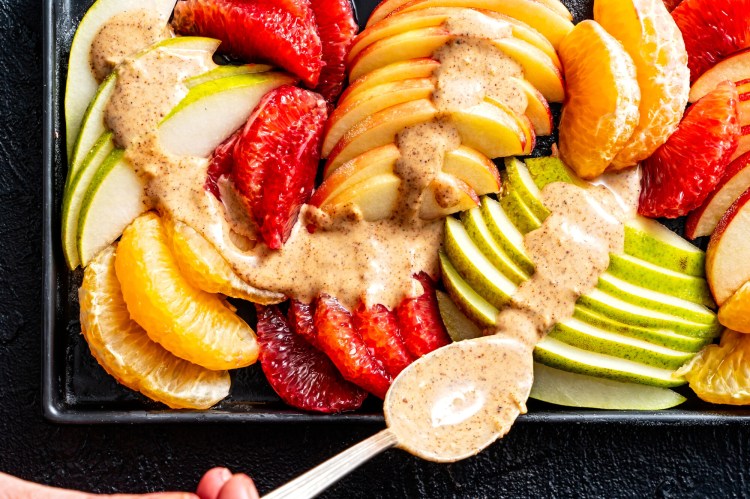One principle of a good salad is that it’s chock-full of the bites worth digging around for. So why not make a salad that’s only treats? Go all in on the fruits and nuts. Skip the lettuce and the winter squash.
An enticing fruit salad offers a wide spectrum of textures and flavors: crunch and creaminess, salt and sweetness. Generally: variety. This time of year it can be filled with crunchy apples and pears, juicy citrus and crisp-tender Fuyu persimmons.
In a savory salad, the dressing’s fatty element is key to bringing a desired softness, whether it’s dairy or oil. While you could toss your fruits in dairy, like the sour cream in an ambrosia, or drizzle them with olive oil like a caprese (also a fruit salad!), there’s another rich and savory fat that works well: nuts blended into a butter.
Employ a nut butter you might’ve used for breakfast oatmeal or toast or apple slices. It can be made with almonds, cashews or peanuts, to name a few, or a seed butter such as sunflower or even tahini. Lots of black pepper and freshly grated ginger deliver a spicy kick reminiscent of gingerbread cookies or cake, which you know goes well with winter fruit. Lime or lemon juice and zest brighten, and water thins the sauce to a drizzle. Eventually.
Adding water to nut butters can be mystifying because the mixture will initially stiffen before it slouches. As Cook’s Illustrated magazine explains, the carbohydrates in the nuts and seeds glom to the liquid, resulting in a thicker mixture, until enough liquid is added so the mixture thins. Science!
Once you have a nutty, spiced and bright dressing, it’s time to assemble the salad. The simplest version I’ve made is sliced apples drizzled with the nut butter dressing (you already know from after-school snacks that apples and nut butter make a good pair). But a fruit salad dazzles when there are at least three types of fruit on offer. Cut the fruits into one- or two-bite pieces, depending on whether you want to eat the salad with a fork, spoon or fingers. Then layer the fruits on a plate and drizzle the dressing over top.
Be sure to lightly season your fruits with salt, too, so their flavor is punchy and in balance with the dressing. While the salad can stand alone, it’s also amenable to shape-shifting. For a sweet application, eat it over yogurt, muesli or toast. Or for a savory version, add bitter or baby greens, or roasted squash. But only if you really want to.
Before digging in, admire the variety of flavors and textures – what a great salad you just made.

Fruit Salad with Nut Butter Dressing. Photo for The Washington Post by Scott Suchman
Winter Fruit Salad With Nut Butter Dressing
Storage: Refrigerate leftover dressed salad for up to 2 days; before serving again, taste, and season with more lime juice and/or salt, if needed.
NOTE: To keep the apples and pears from browning, rub them with the cut sides of the juiced lime halves.
– – –
INGREDIENTS
1/4 cup almond butter (salted or unsalted both work; may substitute another nut or seed butter of your choice)
1/2 teaspoon finely grated lime zest
1 tablespoon fresh lime juice (from 1 lime), plus more to taste
1 teaspoon finely grated fresh ginger
1/2 teaspoon freshly ground black pepper
Water, as needed
Flaky or fine sea salt
8 cups chopped or thinly sliced pieces of mixed winter fruit, such as apples, pears, figs, Fuyu persimmons, oranges and/or tangerines
– – –
STEPS
In a small bowl or 2-cup liquid measuring cup, stir together the almond butter, lime zest and juice, ginger, and pepper. Add water, 1 tablespoon at a time, until the dressing is pourable, then dip a piece of fruit in and taste; add more salt and/or lime juice until the dressing is assertively bright and rich, yet tastes balanced with the fruit. You should get about 1/2 cup.
Arrange the fruit on a large platter or plates and sprinkle lightly with salt. Drizzle with half to three-quarters of the dressing, enough to lightly cover, and serve slightly chilled or at room temperature.
Nutrition Information per serving (2 cups): Calories: 256; Total Fat: 5 g; Saturated Fat: 1 g; Cholesterol: 0 mg; Sodium: 78 mg; Carbohydrates: 56 g; Dietary Fiber: 11 g; Sugar: 40 g; Protein: 4 g
Send questions/comments to the editors.



Comments are no longer available on this story